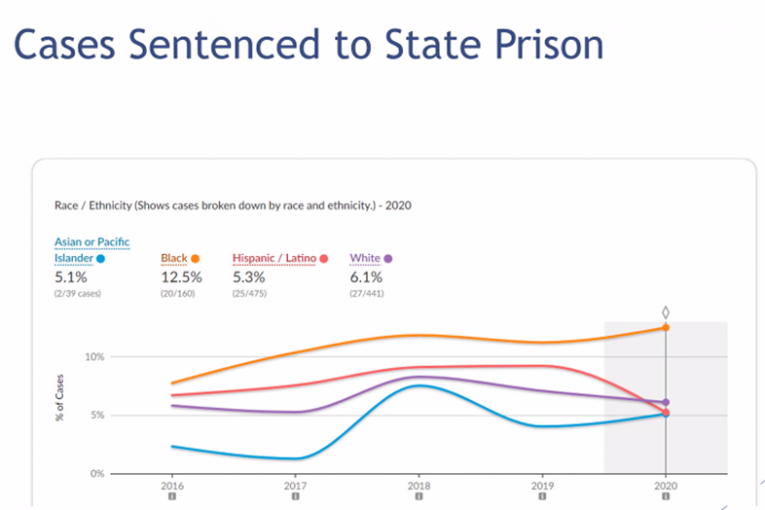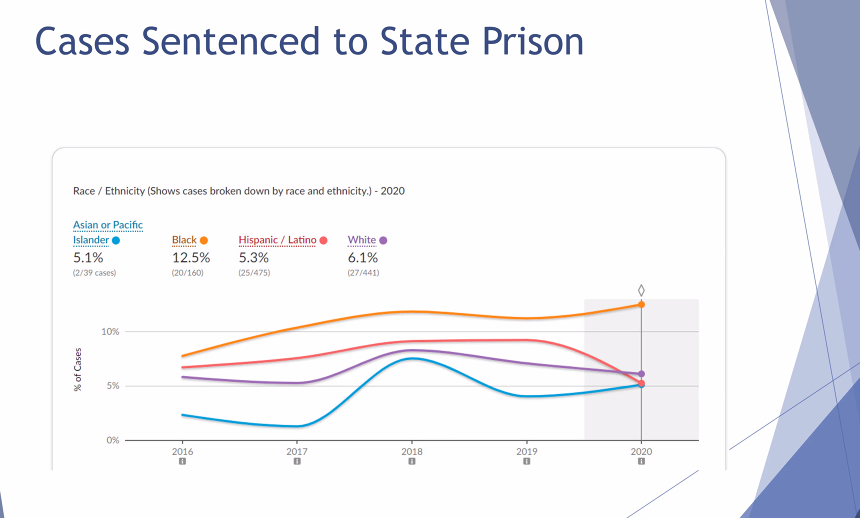

By David M. Greenwald
Executive Editor
Woodland, CA – One of the biggest issues facing the Yolo County DA is one of racial disparities. And while I remain skeptical of the Yolo County DA’s push for data transparency, credit them with one thing – they did not shy away from unpleasant data in their discussion on Tuesday. But as Chief Deputy DA Jonathan Raven acknowledged in the virtual townhall, the data leave them with “more questions than answers.”
The story (as reported on Wednesday by Robert Hansen) begins as it usually does in the criminal legal system, with a disproportionate amount of Black people who are arrested, according to Gipsy Escobar of Measure for Justice, the group partnering with the DA’s office on the Data Transparency.
Black people make up roughly 3.2 percent of the population in Yolo County yet accounted for 17.2 percent of the cases directed to the Yolo DA’s Office from 2016-2020 according to the data portal.
“There certainly is a disproportionately in the number of Black defendants who are referred to the prosecutor by law enforcement,” Escobar said.
The data – which only goes through 2020, show that there are little, if any, disparity by race in the cases that are prosecuted by the DA’s office.
“We see parity in the lines when we look at how the cases are being prosecuted,” Escobar said. “You want parity because you want to know that there were no outside factors in how the cases were prosecuted.”
The big disparity is in the prison rate. Raven said, among (individuals (who) are committing felonies and being sentenced to prison. So if you were to look at 2020… you can see that 12.5% Blacks (versus) white, 6.1 (percent). What we found basically is that it’s 1.6 times more likely that someone who is black, who is convicted of a felony will go to prison versus someone who is white.”
Raven said, “The question is, why is that? That’s the hard question and what can we do to change that?” He said, “Is it because of criminal history or the crimes that are committed or going way back tto systemic racism or nursery school ability to go to nursery school or being suspended or expelled from high school or graduating high school or college?”
Raven admitted, the “disparity… is troubling in many ways.”
There are several important points to break down.
First of all, what these data show is that the disparity exists throughout the system. It starts with who is getting arrested by police in the first place. And actually as I think Raven was getting at, even before that because criminal history starts before arrests and it starts at a very young age with education and resource disparities.
The problem – as we know from research exists at each level – people of color, particularly Blacks are more likely to be arrested, they are more likely to be charged, they are more likely to be convicted and once convicted they are more likely to be sentenced to prison.
The data from Yolo don’t show this, but the national studies show, even when controlling for criminal history, Black are more likely to see prison time and receive longer sentences than whites.
From the DA’s perspective, the problem in some ways starts before they get the cases – it starts with economic and educational disparities and it also starts with differentials in arrest rates.
Since most of these data date back to 2020, one thing that this does not show – the problem is not in terms of charging decisions. Or at least, the decision to charge or not charge does not seem to have a racial component. That leaves one to question whether the racial blind charging policy that the DA’s office has trumpeted will have much impact.
With that said, the data has limitations – it only shows us the decision to charge or not charge, not the decision of what to charge with. So we need to take that into account.
The other critical point is that the DA is now acknowledging that the points raised by Public Defender Tracie Olson back in June of 2020 were valid.
Olson, if you recall went on TV during the Black Lives Matter protests around the country and pointed out, “Honestly we see Black people go to prison for crimes that white people don’t go to prison for…On April 20, I looked at the jail population. We had about a little under 200 people in the jail, 49 of whom were Black.”
She explained, “So that’s 25% of our Yolo County jail population is Black. Yolo County’s demographic population is 3% Black. So we have over an 800% over-representation of Black men and women in our local jail. So it is a local problem.”
DA Jeff Reisig responded with a series of blistering attacks on the public defender.
He said, “Yolo County Public Defender Tracie Olson’s recent broadside against the justice system in our county was inaccurate, irresponsible, and insulting to both prosecutors and the judiciary.”
As we now know, the comments were completely accurate. She never assigned blame to them.
Jonathan Raven this week acknowledged that the disparities are “troubling” and that they raise “more questions than answers.”
They continue to point out, as Gipsy Escobar did that many of the Blacks in jail are from out of county, without explaining why that point is significant and as the data show, it almost doesn’t matter. Regardless of where they are from, once they get into the Yolo County system, the prison rate is far higher for Blacks than whites.
The bottom line is that it is good that the DA’s office is now acknowledging the problem – unfortunately the DA took clear shots at the public defender for simply pointing out what they now acknowledge to be accurate and have never publicly acknowledged that the public defender was right all along.


Actually, I don’t think this “forced” them to do anything. Racial disparities are obvious, and not limited to Yolo county. For that matter, it’s not limited to the criminal justice system.
The more difficult, perhaps unanswerable question is “why”.
Actually, it’s not just “local”. Nor is it necessarily a “problem” with the local criminal justice system. Of course, if there’s a relatively small sample size in the first place, the percentages might be misleading.
In any case, the public defender alleged that there’s a “problem” with the DA’s office, and this is not necessarily borne out by any facts presented on here.
The reason absolutely “matters”, as it would address whether or not there’s actually a problem with the system. Disparities in-and-of themselves do not do so. The latter point should be emphasized repeatedly, as it appears to be the entire basis of concern among some progressives.
It’s also a dangerous and irresponsible point of view, in that it would inevitably lead to a push to ensure that outcomes are “representative” of a percentage of a population – regardless of differences in crime rates.
So, if there’s a racially-blind charging policy, and yet disparate outcomes continue, this is actually strong evidence that there is no systemic racism, let-alone localized systemic racism.
I’m sure you’ll be on that.
The first reaction from Reisig however, not withstanding your accurate point was to deny the charges by the public defender. It was only when their own data portal confirmed her critique that the DA and his office acknowledged what you admit is obvious and not limited to Yolo County.
Perhaps he was reacting to this, as it implies that the “problem” is within the DA’s office, itself:
Ultimately, I’d have to agree that disparities are a problem for society at large – regardless of how or why they occur.
But I wouldn’t start with (or necessarily alter) the criminal justice system itself.
When the “rubber meets the road”, I don’t think that most people care about the skin color of whomever hit them over the head and robbed them. But, the fact that one group or another participates in those activities at a higher-level than other groups ensures that disparities in outcomes will continue. (It also can lead to resentment toward entire groups – in other words, actual racism.)
I’ve always thought that long-term solutions are going to have to primarily come from those who are disproportionately causing problems for others, rather than from progressives. I’m not sure that society at large cares enough about disparity in outcome to actually change it. (Plus, there are successful and unsuccessful individuals in every group – which might be viewed as evidence that the system itself is not “stacked” against one group or another.)
I don’t believe that people care all that much about their “own” skin color, either. It’s not a “club”, with organized membership rules, etc. Plenty of white a-holes around, for example. And they go to prison, get shot by police, too.
For that matter, I don’t think that white people are at the “top of the list”, in terms of refraining from causing problems for others.